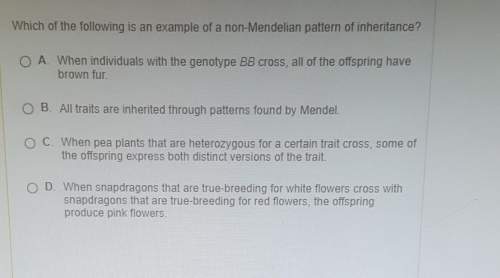
Biology, 08.01.2021 17:20 jlluminate91671
Ginny Genestudy performs the following experiment. She wants to replicate a test strand of DNA using wildtype of Saccharomyces cerevisiae (budding yeast) and two mutants which she calls poor-rep1 and poor-rep2. She performs the experiment with her wildtype strain, and her test DNA strand replicates perfectly. She does the same experiment with poor rep-1 and discovers that this strain can only synthesize the DNA strand if she adds a purified wildtype DNA polymerase-a exogenously. When she performs the experiment with poor rep-2 she discovers that adding wildtype DNA polymerase-a has no effect. Which of the following scenarios is a possibility for the poor rep-1 and poor rep-2 strains?
A. The poor rep-1 strain has a mutation in the gene that codes for either PriS or PriL but not the gene encoding polymerase-a, whereas the poor rep-2 strain has a mutation in the gene that codes for polymerase-a.
B. The poor rep-1 strain has a mutation in the gene that codes for PriS and polymerase-a, but not PriL, and the poor rep-2 strain has a mutation in the gene that codes for PriS or PriL but not the gene that codes polymerase-a
C. The poor rep-1 strain has a mutation in the gene that codes for PriL and polymerase-a, but not PriS, and the poor rep-2 strain has a mutation in the gene that codes for polymerase-a, but not PriS or PriL
D. The poor rep-1 strain has a mutation in the gene that codes for Pola, but not for either PriS or PriL, and the poor rep-2 strain has a mutation in the gene that codes for either PriS or PriL but not for the gene that codes for polymerase-a .
E. All of the above are correct

Answers: 1


Other questions on the subject: Biology

Biology, 22.06.2019 05:00, Foxfire5109
Identify the examples in which sam interacts only with natural resources
Answers: 2

Biology, 22.06.2019 09:10, ballin4534
Refer to this portion of a dichotomous key for fish identification to answer the question. 1. (a) has a single dorsal fin ® 5 (b) has a double dorsal fin ® 2 2. (a) one fin is spiny, the other is smooth ® 3 (b) one fin is not spiny or smooth ® 4 5. (a) has small fin on back near tail ® 6 (b) has no fin on back near tail ® 7 6. (a) has barbs near the mouth ® catfish (b) does not have barbs near the mouth ® 10 7. (a) tail is asymmetrical ® 8 (b) tail is symmetrical ® 9 10. (a) scales are small ® trout (b) scales are large ® whitefish what is the next step to complete to identify a fish that has a single dorsal fin, no fin on the back near the tail, and no barbs near the mouth? step 2 step 5 step 7 step 10
Answers: 2

Biology, 22.06.2019 10:20, XxDonaldTrumpxX452
The function of the excretory system is to control homeostasis and
Answers: 1

Biology, 22.06.2019 18:00, Destinationz
Which of the following can be assumed about the layers in areas 2 and 4
Answers: 1
You know the right answer?
Ginny Genestudy performs the following experiment. She wants to replicate a test strand of DNA using...
Questions in other subjects:


Business, 15.07.2019 11:30


Social Studies, 15.07.2019 11:30

History, 15.07.2019 11:30

History, 15.07.2019 11:30


Mathematics, 15.07.2019 11:30

Health, 15.07.2019 11:30

History, 15.07.2019 11:30




